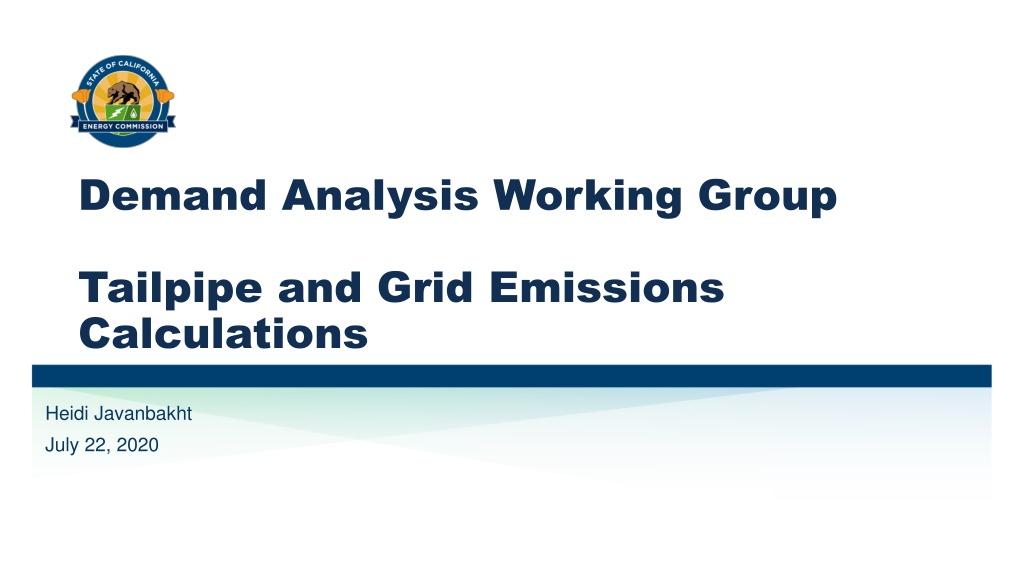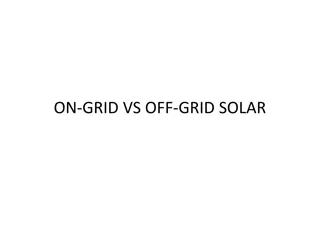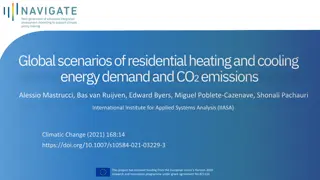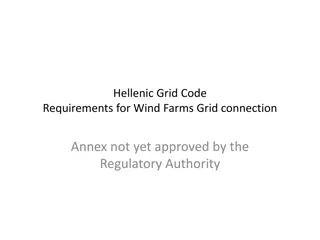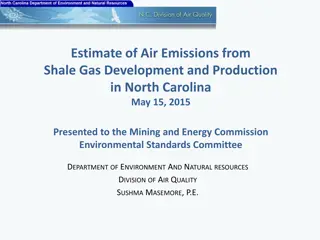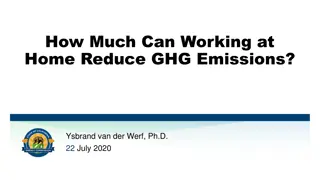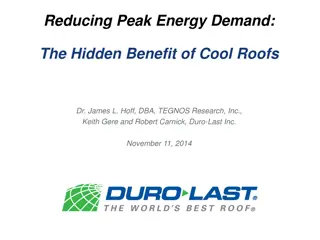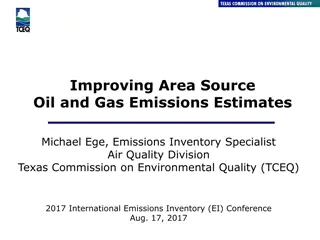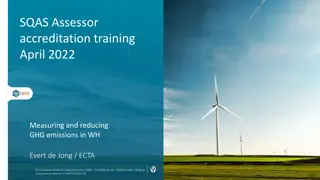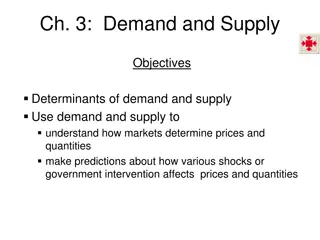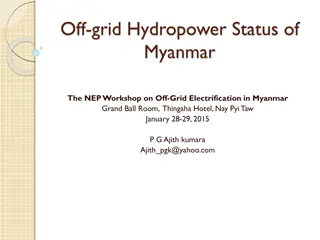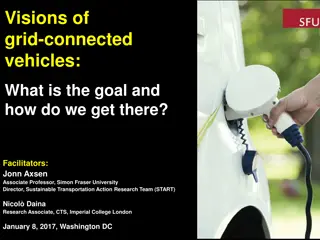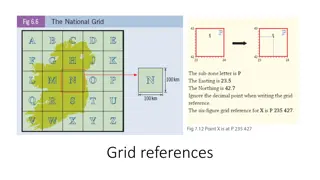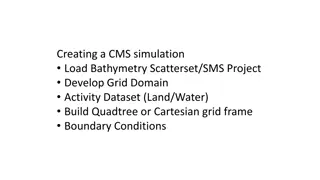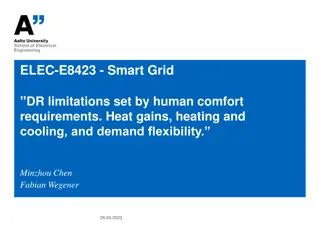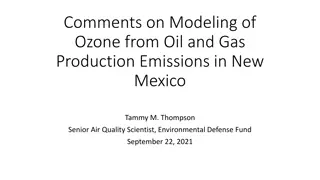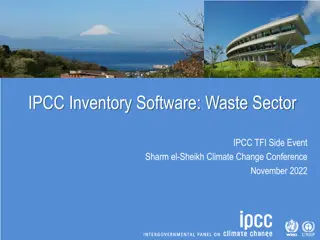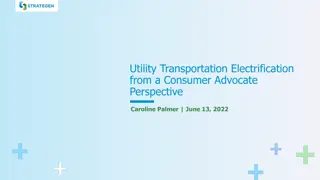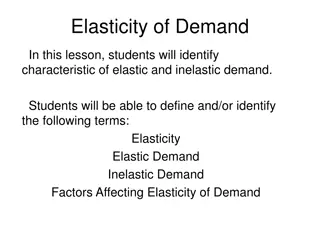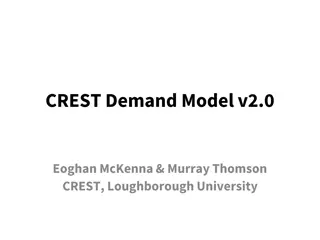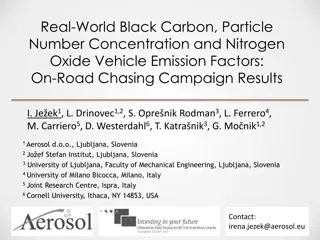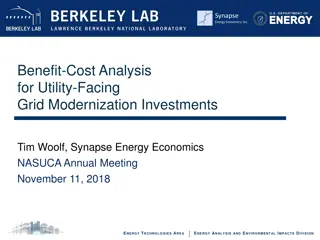Demand Analysis Working Group: Tailpipe and Grid Emissions Calculations Overview
This report discusses the methodology for calculating tailpipe emissions using vehicle stock and VMT data, along with grid emissions from charging PEVs. Challenges include differences in vehicle classifications and lack of trip forecast calculations. Mapping LDVs from CEC classes to EMFAC classes was done based on vehicle characteristics and vintage. The analysis focuses on reducing energy costs, curtailing GHG emissions, and ensuring a reliable energy supply as part of California's vision for a sustainable future.
Download Presentation

Please find below an Image/Link to download the presentation.
The content on the website is provided AS IS for your information and personal use only. It may not be sold, licensed, or shared on other websites without obtaining consent from the author. Download presentation by click this link. If you encounter any issues during the download, it is possible that the publisher has removed the file from their server.
E N D
Presentation Transcript
Demand Analysis Working Group Tailpipe and Grid Emissions Calculations Heidi Javanbakht July 22, 2020
Background CEC vision: the Energy Commission is committed to reducing energy costs, curtailing greenhouse gas emissions, and ensuring a safe, resilient, and reliable supply of energy Transportation is 40.1% of overall GHG emissions in the state* SB 100: Requires that zero-carbon resources supply 100% of electric retail sales to end-use customers by 2045 Future work will include demand scenarios evaluating the impacts of various strategies on transportation energy demand and GHG emissions *CARB 2019 Edition, California GHG Emission Inventory: 2000-2017, page 6 2
Overview of Methodology Tailpipe Emissions: Emission factors from CARB s EMFAC are applied to the CEC s vehicle stock and VMT Grid Emissions from Charging PEVs: Emission factors determined by the CEC s Supply Analysis Office are applied to the forecasted hourly electricity consumption 3
Tailpipe Emissions Annual Emissions = Vehicle Stock x ((RUNEX x VMT)+(STREX x Trips)+(IDLEX x Oper_Days)) Italicized variables are based on the CEC TEDF We will include the off-model adjustment factors for gasoline LDVs (CARB published guidance in response to the SAFE Vehicle Rule) Challenges CEC vehicle classifications differ from EMFAC vehicle classifications CEC does not calculate number of trips for the forecast 4
Tailpipe Emissions: Mapping LDVs CEC Class CEC Class_ID 1A 2A 3A 4A 5A 6A 7A 8A 9A 10A 11A EMFAC 2017 Class LDA LDA LDA LDA LDA LDA LDT1 LDT2 MDV MDV MDV Mapping was done by class, fuel, and vintage CEC forecast uses more vehicle classifications than EMFAC To simplify, we performed a one- to-one class mapping Mapped based on class definitions and CARB analysis of MY2018 vehicles Car-Subcompact Car-Compact Car-Midsize Car-Large Car-Sport Cross/Ut-Small-Car Cross/Ut-Small-Trk Cross/Ut-Midsize Sport/Ut-Compact Sport/Ut-Midsize Sport/Ut-Large Sport/Ut-Heavy(8,500- 10,000) Van-Compact Van-Std Van-Heavy(8,500-10,000) Pickup-Compact Pickup-Std Pickup-Heavy(8,500-10,000) LHD1 Source: CEC analysis 11B 12A 13A 13B 14A 15A 15B LHD1 LDT2 MDV LHD1 LDT2 MDV 1A 2A 3A 4A 5A 6A LDA LDT1 LDT2 MDV Source: CARB analysis of MY2018 Vehicles 100% 0% 0% 0% 100% 0% 0% 0% 94% 0% 6% 0% 86% 100% 0% 14% 0% 58% 37% 5% 0% 0% 0% 0% 5
Tailpipe Emissions: Mapping MD- HD Vehicles CEC Class EMFAC Class . GVWR6 T6 Ag GVWR6 T6 CAIRP small GVWR6 T6 instate construction small GVWR6 T6 instate small GVWR6 T6 OOS small GVWR6 T6 Public GVWR6 T6 utility GVWR6 T6TS . Source: CEC analysis Based on CEC and EMFAC class definitions CEC classes map to more than one EMFAC class Allocated CEC stock by class, fuel, and vintage according to the percent of stock in each EMFAC class 6
Tailpipe Emissions: Trips Adjustment Trips are used to calculate engine start emissions Because CEC VMT differs from EMFAC VMT, it can be inferred that the trips would also differ LD Vehicles Adjusted trips per vehicle by applying a ratio of CEC VMT per vehicle to EMFAC VMT per vehicle MD-HDVehicles For 2020 we are adjusting trips similar to LDVs For 2021, EMFAC may use CA-VIUS for VMT which is consistent with the CEC MD-HD models. Therefore, VMT per vehicle will align and the adjustment will no longer be required 7
Grid Emissions (from Charging PEVs) Mid-Case 2030 Average Grid Emission Intensity Factors (Metric Tons CO2/ MWh) HOURS 0 1 2 3 4 5 6 7 8 9 10 11 12 13 14 15 16 17 18 19 20 21 22 23 1 0.186 0.195 0.199 0.200 0.197 0.186 0.169 0.162 0.127 0.079 0.064 0.060 0.059 0.064 0.073 0.135 0.166 0.145 0.141 0.146 0.153 0.162 0.174 0.181 M o n t h 2 0.159 0.166 0.172 0.172 0.168 0.156 0.142 0.136 0.080 0.050 0.043 0.041 0.041 0.042 0.046 0.070 0.140 0.130 0.119 0.122 0.129 0.136 0.147 0.153 3 0.138 0.145 0.148 0.146 0.139 0.124 0.117 0.120 0.073 0.045 0.040 0.039 0.039 0.039 0.040 0.043 0.080 0.110 0.097 0.101 0.106 0.117 0.126 0.133 4 0.104 0.108 0.110 0.108 0.099 0.092 0.089 0.083 0.047 0.039 0.036 0.036 0.036 0.036 0.037 0.038 0.047 0.074 0.068 0.081 0.080 0.082 0.090 0.098 5 0.088 0.093 0.095 0.093 0.088 0.084 0.081 0.067 0.042 0.037 0.036 0.036 0.036 0.036 0.035 0.038 0.045 0.055 0.058 0.084 0.085 0.076 0.077 0.084 6 0.094 0.101 0.105 0.107 0.106 0.101 0.090 0.064 0.045 0.039 0.038 0.037 0.037 0.037 0.038 0.041 0.046 0.057 0.065 0.087 0.101 0.088 0.088 0.095 7 0.161 0.168 0.173 0.174 0.172 0.169 0.160 0.139 0.089 0.070 0.066 0.064 0.064 0.065 0.071 0.084 0.098 0.105 0.115 0.132 0.140 0.146 0.153 0.159 8 0.210 0.219 0.224 0.226 0.221 0.213 0.207 0.188 0.102 0.076 0.070 0.069 0.070 0.072 0.079 0.095 0.123 0.128 0.134 0.147 0.155 0.165 0.186 0.199 9 0.217 0.226 0.229 0.228 0.222 0.211 0.207 0.202 0.118 0.079 0.072 0.069 0.069 0.071 0.081 0.107 0.141 0.141 0.147 0.160 0.174 0.188 0.199 0.208 10 0.208 0.215 0.217 0.217 0.210 0.198 0.189 0.190 0.122 0.069 0.057 0.054 0.054 0.056 0.062 0.094 0.141 0.133 0.141 0.152 0.165 0.180 0.189 0.199 11 0.198 0.204 0.208 0.207 0.205 0.196 0.182 0.169 0.096 0.065 0.058 0.056 0.057 0.062 0.079 0.143 0.163 0.144 0.147 0.154 0.161 0.170 0.182 0.189 12 0.211 0.218 0.222 0.223 0.221 0.213 0.198 0.188 0.136 0.088 0.075 0.071 0.071 0.078 0.094 0.167 0.179 0.159 0.159 0.163 0.171 0.180 0.193 0.202 Source: CEC Supply Analysis Office 8
Discussion Questions Which GHG and criteria pollutants should we quantify? Should we calculate CO2 emissions? Or CO2e emissions (which include CH4 and N2O)? Note that grid emissions only account for CO2 Is it useful to know the annual NOx or other criteria pollutant emissions associated with the forecast? 9
Closing Acknowledgements CARB EMFAC team Angela Tanghetti, CEC Supply Analysis Office Alex Lonsdale for completing the mapping Bob McBride for assisting with the MD-HD mapping and other assumptions Jesse Gage, Mark Palmere, and Aniss Bahreinian for assisting with the LDV mapping Elena Giyenko for her initial work Questions? Heidi.Javanbakht@energy.ca.gov 10
